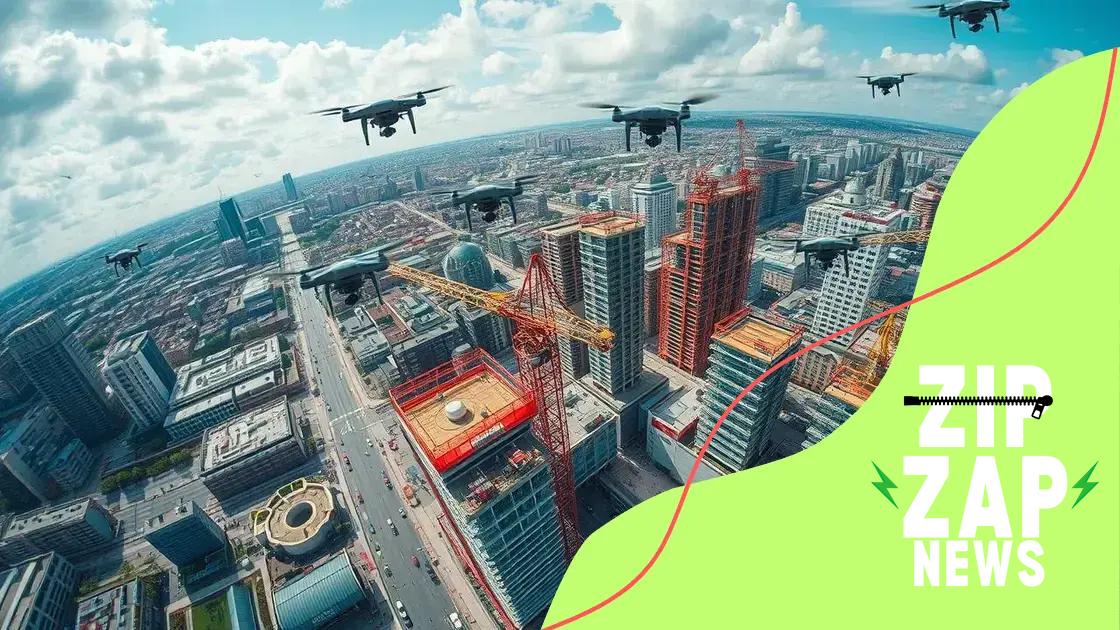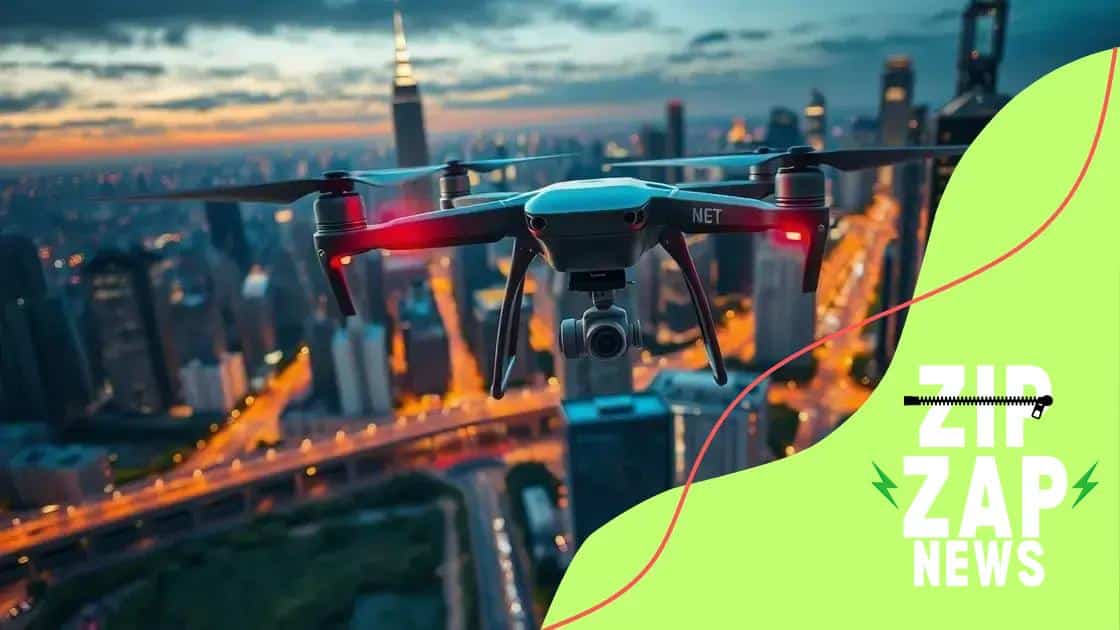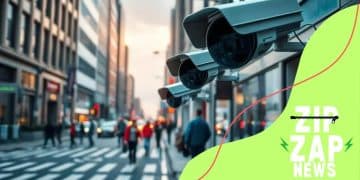Drone technology in urban infrastructure development is transforming cities

Drone technology in urban infrastructure development enhances efficiency, safety, and sustainability, offering innovative solutions for planning, inspections, and real-time data collection, while overcoming challenges like regulation and public acceptance.
Drone technology in urban infrastructure development is reshaping how cities approach growth and planning. Have you ever wondered how this tech could improve city life? Let’s dive into its potential.
Overview of drone technology in urban planning
In today’s urban landscape, drone technology is emerging as a powerful tool for effective city planning. This innovative approach is changing how cities are built and maintained. Have you ever seen a drone capture stunning aerial shots of a construction site? That’s just the beginning of its potential.
What is Drone Technology?
Drone technology refers to the use of unmanned aerial vehicles (UAVs) equipped with advanced sensors and cameras. These drones can provide real-time data and high-resolution images, which are invaluable for urban planners.
Benefits of Drones in Urban Planning
Using drones in urban planning has numerous advantages.
- They allow for efficient data collection.
- Drones can significantly reduce the time required for site surveys.
- They help in monitoring construction progress from above.
- Risk assessment becomes easier through aerial views.
Furthermore, drone technology helps visualize complex projects. Imagine seeing how new buildings will fit into the existing skyline before they are even built! This capability leads to better-informed decisions.
As cities expand, drone technology can also enhance the management of urban infrastructure. From road networks to parks, drones gather data to identify areas needing improvement.
Real-World Applications
Many cities are already employing drones for various planning initiatives. For example, they are used to assess building conditions, monitor environmental impacts, and even assist in emergency response planning. These applications showcase how drone technology integrates with urban development seamlessly.
Drone surveys can uncover crucial insights about land use and demographics. Planners can make better choices by analyzing these findings. Moreover, data obtained through drones is often more accurate than traditional methods, increasing the reliability of the information.
In summary, embracing drone technology in urban planning is not just beneficial; it is essential for modern cities aiming to grow sustainably and intelligently.
Benefits of using drones in infrastructure development
Using drones in infrastructure development offers numerous benefits that can enhance efficiency and accuracy. Drones are quickly becoming essential tools for engineers and planners alike. They provide unique solutions that traditional methods simply can’t match.
Increased Efficiency
One of the main advantages of drone technology is its ability to streamline processes. Drones can cover large areas quickly, allowing for faster surveys and inspections. Instead of spending hours or days collecting data on-site, teams can gather critical information in a fraction of the time.
Cost Savings
In addition to saving time, drones can significantly reduce costs for infrastructure projects. Utilizing drones limits the need for extensive labor and expensive equipment. This efficiency translates into lower project costs, making it an attractive option for developers.
- Reduced labor costs due to less manual surveying.
- Minimized equipment expenses by relying on UAVs.
- Less downtime during inspections and data collection.
- Quicker decision-making leads to faster project completion.
Moreover, drone data collection is not just about speed; it’s also about precision. The technology enables accurate mapping and modeling, which are vital during the planning and construction stages. This precision lowers the likelihood of costly errors down the road.
Enhanced Safety
Drones play a critical role in enhancing safety on construction sites. High-risk inspections in hazardous areas can be performed remotely, reducing the need for personnel to work in dangerous conditions. This capability ensures that safety is prioritized without compromising the quality of assessments.
Another significant safety benefit stems from real-time data monitoring. Drones can continuously assess site conditions, offering immediate feedback that can prevent accidents and identify potential risks swiftly.
Overall, the use of drones in infrastructure development is transforming how projects are executed. They not only improve efficiency and cut costs but also prioritize safety, making them a smart choice for modern urban development.
Key applications of drone technology in cities

The key applications of drone technology in cities are changing how urban environments are managed and developed. Drones are proving to be versatile tools that serve many purposes across various sectors.
Urban Planning and Development
In urban planning, drones play a crucial role by providing comprehensive aerial surveys. They collect accurate data, enabling planners to create precise maps and models. These models help visualize how new developments will fit into existing landscapes. The integration of drones allows for better decision-making and resource allocation.
Infrastructure Inspections
Another significant application is in infrastructure inspections. Drones can safely monitor bridges, roads, and buildings more efficiently than traditional methods. By flying close to structures, they provide detailed assessments, allowing for early identification of maintenance needs.
- Quickly assess hard-to-reach areas without scaffolding.
- Conduct regular inspections to enhance safety.
- Document conditions for maintenance records.
- Reduce downtime and costs associated with manual inspections.
Moreover, drones can deliver high-resolution images and data, making it easier to ensure compliance with safety regulations.
Emergency Response and Disaster Management
In emergencies, drones can be deployed swiftly to assess damage and identify areas needing immediate attention. For instance, after natural disasters, drones can capture images of affected regions, providing valuable information to first responders. This capability enhances situational awareness and supports effective rescue operations.
In urban areas prone to flooding or wildfires, drones help monitor conditions and predict potential hazards. Having real-time data available can lead to quicker responses and better management of emergency situations.
Environmental Monitoring
Drones also contribute to environmental monitoring by tracking pollution levels and wildlife patterns. Equipped with sensors, they can gather data on air and water quality, helping cities maintain healthier environments. This information can guide policy decisions and promote sustainability efforts within urban settings.
Through these various applications, drones are proving to be invaluable assets for cities, enhancing both operational efficiency and safety. Their ability to collect data quickly and accurately supports multiple sectors, paving the way for innovative urban solutions.
Challenges faced in implementing drone solutions
Implementing drone solutions in urban settings presents several challenges that need to be addressed. While the technology offers incredible benefits, various obstacles can hinder its widespread adoption and effectiveness.
Regulatory Hurdles
One of the main challenges is navigating the complex regulatory environment surrounding drones. There are strict laws governing where drones can fly and how they can be used. These regulations vary by region, making it difficult for organizations to know the legal implications of drone use in urban areas.
Technical Limitations
Another issue lies in the technical limitations of drone technology. Many drones can only operate within a limited range and may struggle with battery life. This limitation can reduce their effectiveness, especially in large urban areas. Furthermore, the need for precise GPS is critical; poor satellite signals in dense cityscapes may lead to navigation issues.
- Range limitations can restrict coverage area.
- Battery life may not support longer missions.
- Signal interference can disrupt data collection.
- High-altitude winds may affect stability and flight safety.
These technical challenges can lead to operational disruptions that could undermine the reliability of drones in crucial situations.
Public Acceptance and Privacy Concerns
Additionally, public acceptance plays a major role in the deployment of drone technology. Many people have concerns about privacy and surveillance, worrying that drones could invade personal space. Building trust and educating the community about the benefits of drones can help alleviate these fears.
Finally, the costs associated with integrating drones into existing systems can pose financial challenges. Organizations must invest not only in the drones themselves but also in training personnel and maintaining the technology. These costs can be a barrier for smaller companies or municipalities with limited budgets.
Overcoming these challenges will require collaboration between regulators, technology providers, and the public. Addressing the obstacles of regulation, technical feasibility, public perception, and costs will be essential for the successful implementation of drone solutions in urban infrastructure.
Future trends in drone use for urban development
The future of drone technology in urban development is expansive and full of potential. As cities evolve, the integration of drones into various sectors will continue to grow. These advancements will transform how we approach planning, construction, and maintenance.
Enhanced Automation
One major trend is the increase in automation. Drones are being equipped with sophisticated artificial intelligence (AI) systems that allow them to perform complex tasks autonomously. This includes mapping, data collection, and even analyzing site conditions without human intervention. Such capabilities will save time and resources, increasing overall efficiency.
Improved Data Analytics
Moreover, the future will likely see enhanced data analytics capabilities. Drones will generate vast amounts of data, and using AI and machine learning can help process this information faster and more accurately. Through advanced analytics, stakeholders can gain valuable insights into urban dynamics, helping inform impactful decisions.
- Predictive analysis will forecast urban growth trends.
- Real-time data will assist in rapid decision-making.
- Better visualization tools will present findings intuitively.
- Integration with other technologies like IoT will enhance data richness.
This synergy between drones and analytics will create a more informed approach to urban planning.
Sustainability Focus
Furthermore, there will be a stronger emphasis on sustainability in urban development. Drones can monitor environmental conditions, helping cities track pollution and resource use. This monitoring can support initiatives aimed at reducing the carbon footprint of urban areas.
For example, drones can survey green spaces and ensure they are maintained, while also assessing their impact on urban climates. This real-time feedback loop can enhance the effectiveness of sustainability efforts.
Drone Delivery Services
Another future trend is the rise of drone delivery services. As urban areas become more congested, delivering goods via drones presents a solution to transportation challenges. Companies are already testing these services for package delivery and emergency supplies.
This shift could reduce the number of delivery trucks on the road, leading to less traffic and pollution in cities. As regulations evolve, we can anticipate more widespread adoption of drone delivery systems.
Overall, the future of drone technology in urban development is bright and filled with innovation. From automation and data analytics to sustainable practices and delivery services, drones will play a pivotal role in shaping the cities of tomorrow.
FAQ – Frequently Asked Questions about Drone Technology in Urban Development
What are the main benefits of using drones in urban planning?
Drones enhance efficiency, improve safety, and provide precise data collection that supports better decision-making.
What challenges do cities face in implementing drone solutions?
Cities encounter regulatory hurdles, technical limitations, public acceptance issues, and costs associated with drone technology.
How can drones contribute to sustainability in urban areas?
Drones help monitor environmental conditions, track pollution levels, and assess green spaces, supporting sustainable urban practices.
What future trends can we expect from drone technology in cities?
We can expect enhanced automation, improved data analytics, increased focus on sustainability, and the rise of drone delivery services.





